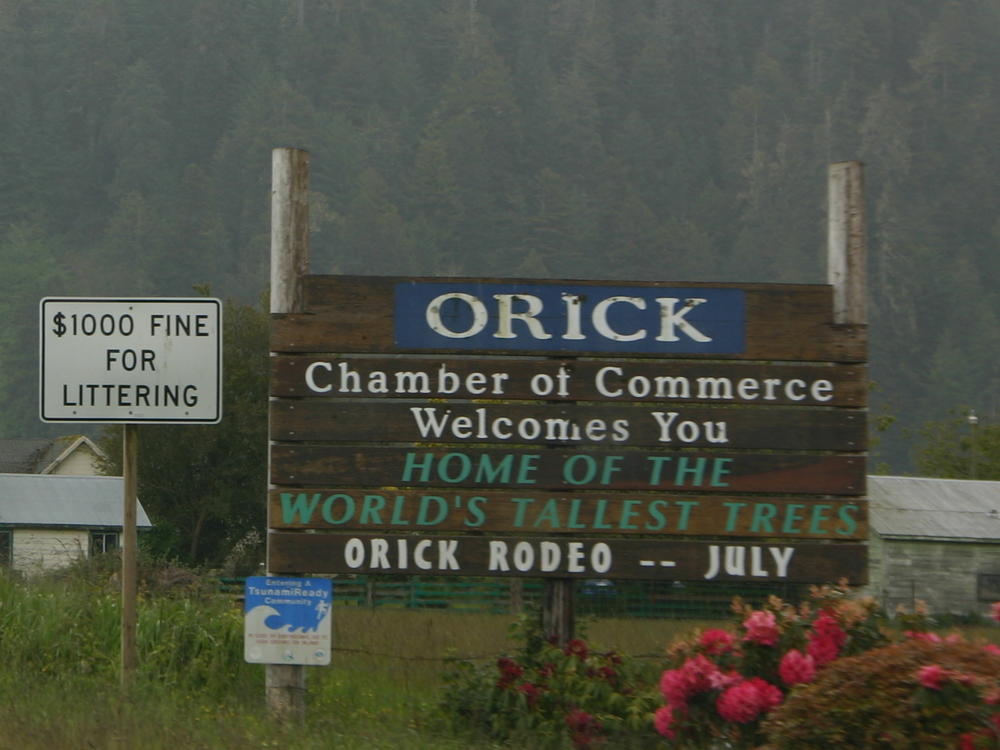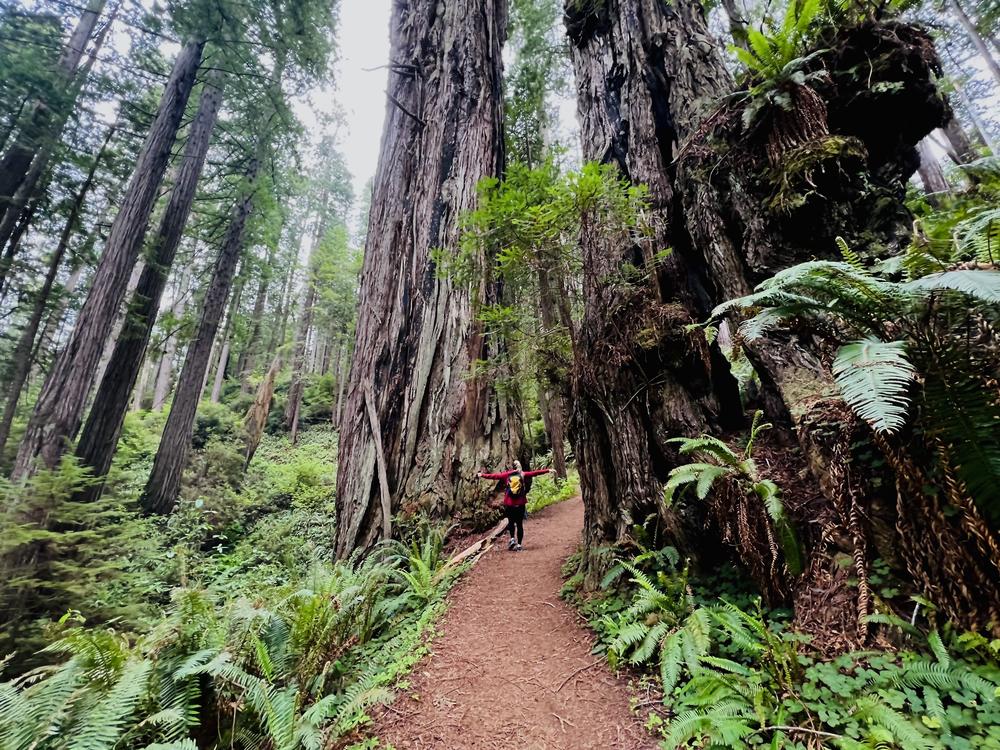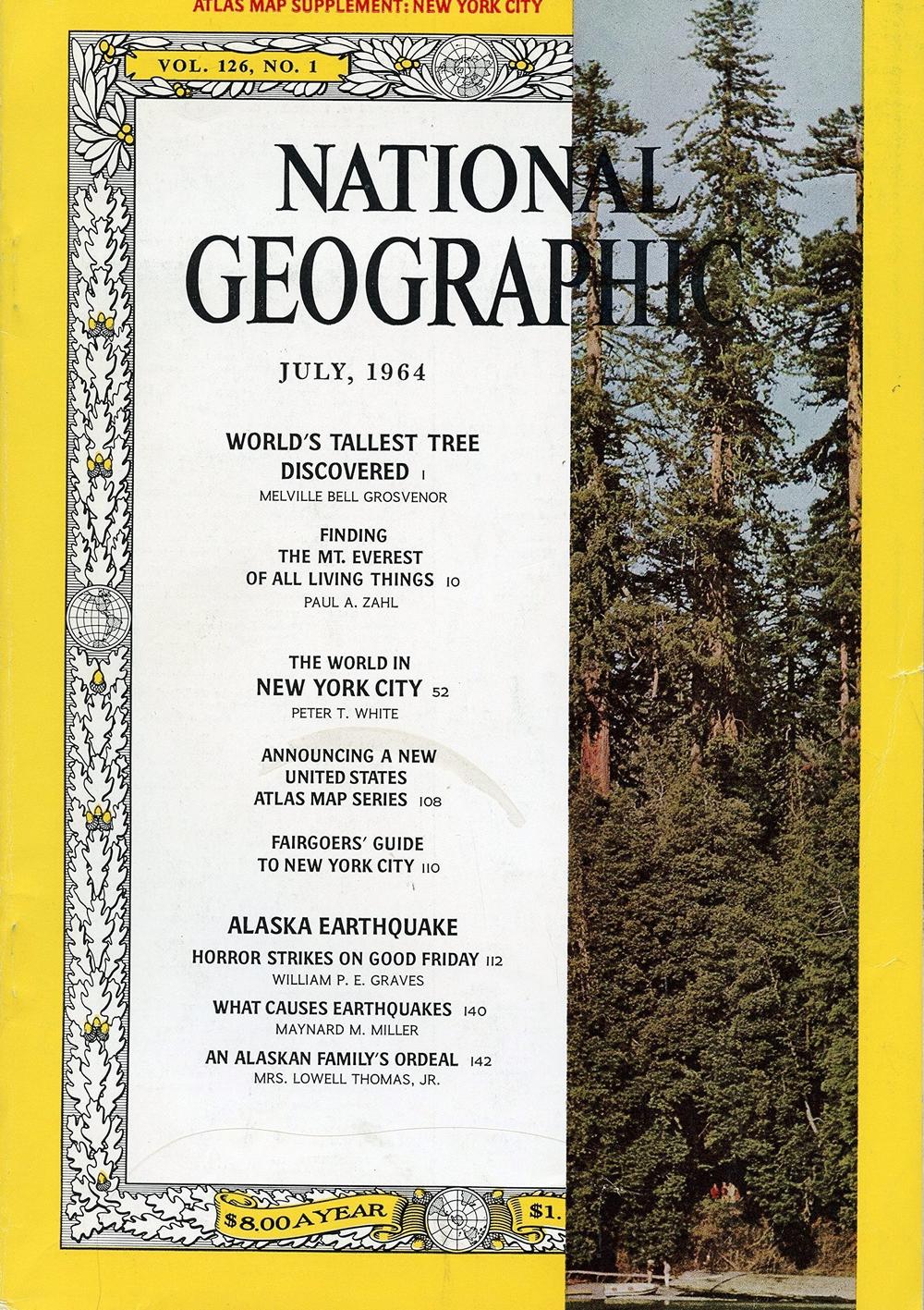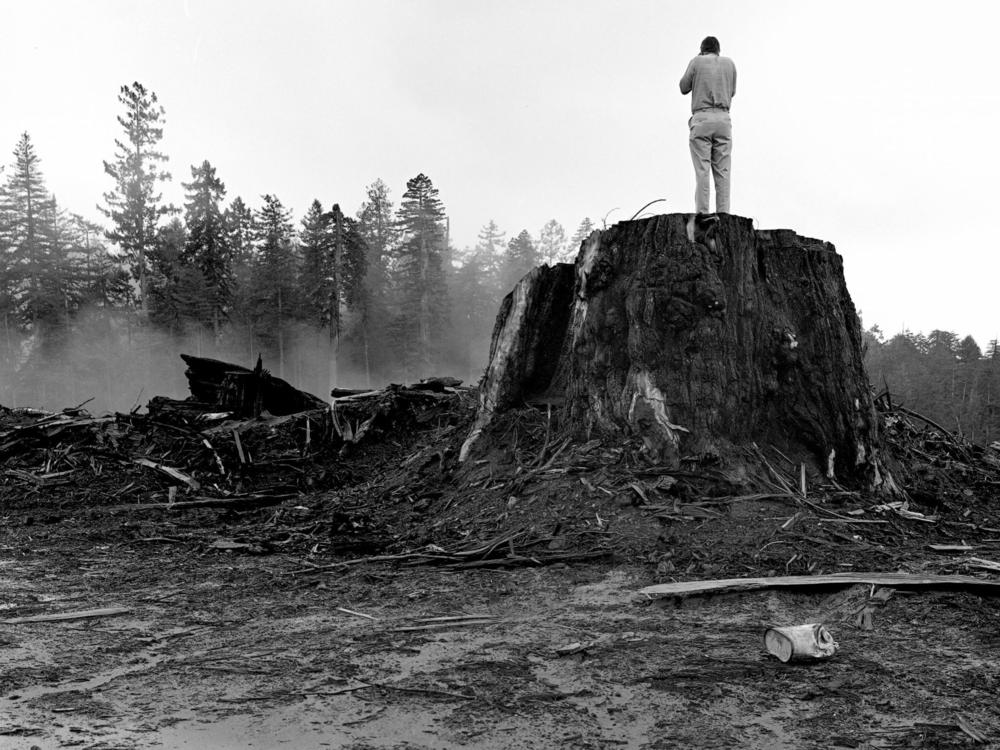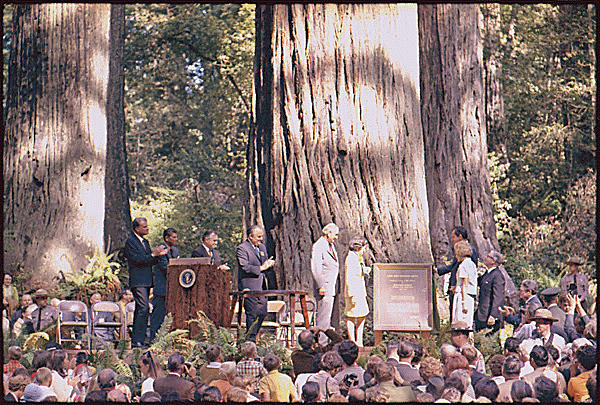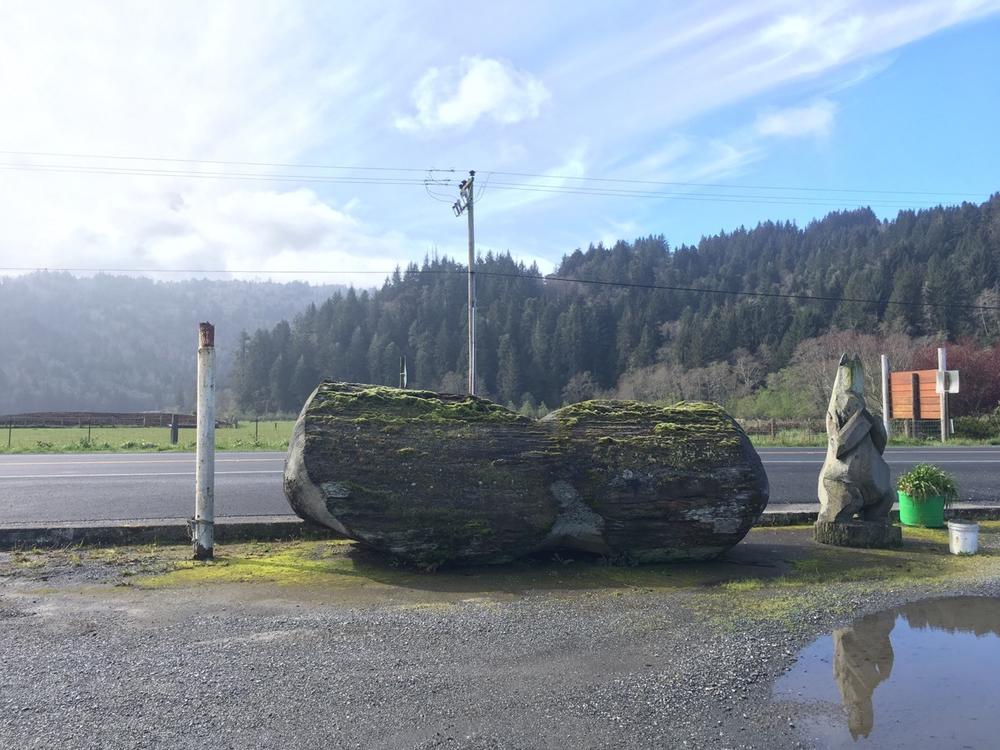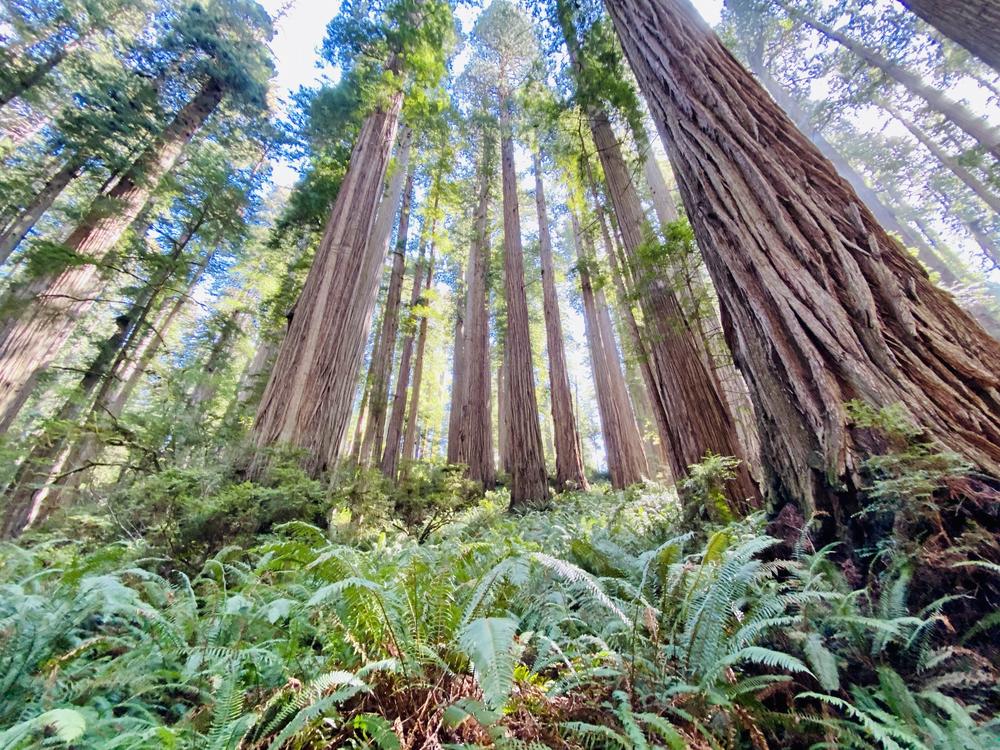Section Branding
Header Content
The tale of a distressed American town on the doorstep of a natural paradise
Primary Content
A few weeks ago, my partner and I drove across the Golden Gate Bridge and headed up Highway 101 for about six hours to visit a spectacular sliver of America. Nestled along roughly 40 miles of Northern California coastline, Redwood National and State Parks is a sprawling park system — three state parks and one national park — housing 133,000 acres of natural wonders. It boasts stunning lagoons, rivers, and beaches, eye-popping hiking and biking trails, a rich array of wildlife, and some of the oldest and tallest trees on the planet.
We hiked the James Irvine Trail in Prairie Creek Redwoods State Park, which has got to be one of the best hikes on the West Coast. The trail starts with a wooden bridge over a flowing creek and instantly leads you into groves of enormous redwood trees. The trees are thousands of years old, with heights as tall as the Statue of Liberty and diameters as wide as 18 feet. They are marvels of evolution, communicating, cooperating, and sharing resources with each other through root systems. They have bark so thick that they can survive scorching wildfires. Scientists trace redwood ancestry back 160 million years, when dinosaurs still roamed the earth.
Meandering miles through this breathtaking primeval forest, the trail leads to Fern Canyon. It's a place so otherworldly that Steven Spielberg chose it as a setting for The Lost World: Jurassic Park. Passing through Fern Canyon, we reached grasslands where we came face to face with a gang of Roosevelt elk. After nervously circumventing the gang, we arrived at Gold Bluffs Beach, where we gazed upon a rocky, forested coast jutting out into the sparkling Pacific Ocean. I cannot recommend this hike enough.
However, the doorstep to this natural treasure — a treasure so valuable that the United Nations has declared it a World Heritage Site — is bleak. It's a town called Orick. Driving through the town on Highway 101 to get to the park, you pass boarded-up motels, ramshackle houses, rusted-out cars, and properties that look like junkyards. Parts of Orick look like the setting for a zombie movie.
I've seen rural towns like Orick before, towns that have gone through economic catastrophes and never recovered. Towns whose abandoned buildings stand as macabre monuments to a more prosperous age. But what makes Orick so strange is it's literally the gateway to this gorgeous World Heritage Site. It's the closest town to the parks. Redwood National Park has an administrative headquarters there. Orick itself sits in a beautiful valley near the ocean, and it's surrounded by lush parkland. It's pretty much the perfect jumping off point for a whole range of outdoor adventures.
So why are its motels all shut down? Why aren't there restaurants or more places for tourists to shop? Why hasn't anyone invested in infrastructure or upkeep? What the heck happened to Orick?
The Contentious Creation Of Redwood National Park
In 1963, a team of scientists with the National Geographic Society, exploring an area just a mile north of Orick, discovered what they declared to be the tallest tree in the world. Towering at 362 feet, the tree was found along Redwood Creek within private logging land. They named the tree Howard Libbey, after a founder of the logging company that owned the land. The tree graced the cover of National Geographic in 1964.
By that point, the mighty coastal redwood forest — which once covered 2 million acres of coast spanning from Big Sur to southern Oregon — had been logged down to an area of just 300,000 acres. Much of that logging took place after World War II, when a housing construction boom fed an insatiable demand for redwood lumber. That was Orick's heyday. Back then, it boasted four sawmills, good union timber jobs, a highway bustling with cars and logging trucks, a slew of restaurants, bars, motels, and shops, a 350-seat movie theater, and a population of almost 3000 people.
However, Orick's thriving timber economy was a threat to one of the last remaining bastions of ancient redwoods. Technological advances had enabled the logging industry to clearcut redwoods at an unprecedented scale. The resulting ecological devastation was contributing to floods and mudslides in the area. Realizing that existing state parks only protected 50,000 acres (about one-sixth) of the remaining forest, environmentalists began an impassioned movement to create a new national park.
The logging companies and workers based in and around Orick hated the idea of creating a new national park. They derived their livelihoods from cutting down trees in the area where the park was proposed. After some squabbles and compromises, however, in 1968 President Lyndon Johnson signed into law an act that created Redwood National Park, protecting 58,000 acres of the forest. To this day, there's a giant grove of old-growth redwoods in the park named Lady Bird Johnson Grove, in honor of the president's wife. Presidents Richard Nixon and Lyndon Johnson, along with First Ladies Lady Bird Johnson and Pat Nixon, came to the area to dedicate it.
The creation of the park, however, did not end the battle between loggers and environmentalists. Over protests, timber companies began cutting down redwoods on land within a half-mile of the park. And so began a second, even more heated battle over proposals to further expand the park.
As momentum for park expansion picked up steam in 1977, local loggers organized a "Talk to America" convoy to Washington, DC. By then, Jimmy Carter, a former peanut farmer, was president. The loggers transported a nine-ton peanut carved out of redwood to give to him. They put a sign on it that said, "It may be peanuts to you, but it's jobs to us!" When the activist motorcade of 25 semi-trucks completed the nine-day journey to the nation's capital, they met with presidential aides and tried to give President Carter the peanut. The aides refused it.
"The redwood peanut actually came back to Orick," says Donna Hufford, a local Orick businesswoman who has lived in the town since 1970. "It's still here. We haven't really made a great icon out of it. But it is here, down in front of the one gas station that we have left."
In 1978, President Carter signed into law an act that expanded the Redwood National Park by 48,000 acres, nearly doubling its size. Secretary of the Interior Cecil Andrus estimated that at least 1,000 timber jobs would be killed in the park's first year of expansion — although he also predicted, probably rightly, that these jobs would be eventually lost anyway, once the forest's resources were exhausted. After all, logging towns across the West Coast — most of which are not located next to national parks — have a history of going bust once the trees in the area have all been cut down. However, in this case, the timber industry had clear boogiemen: hippie-dippie "tree huggers" and the federal government.
"The problem was when the national park took over, you could just start to see the demise of logging," Hufford says. "And that was the people's lifeblood, and they were fighting for it."
Facing protests, Secretary Andrus, an Oregonian who came from a logging family and had worked as a logger himself, fought to include provisions to contain the economic fallout of the park's expansion. The law expanding the park created The Redwood Employees Protection Program, which provided payments, pension benefits, and retraining to timber workers who lost their jobs. A subsequent analysis by the US Government Accountability Office found that the program doled out more than a hundred million dollars to 3,500 former timber workers between 1978 and 1988, far exceeding initial projections. The report also found that only 432 of the 3,500 workers enrolled in retraining programs. The authors blamed program delays and design flaws, including the payments not being tied to retraining, and they wrote "the benefits became a disincentive to work." The fact that there weren't many great jobs in the area to train for probably didn't help. The last payments were made in 1989.
The Failed Promise Of Tourism
This welfare program for displaced workers was never supposed to be a permanent solution to the collapse of the timber industry. Instead, lawmakers and environmental groups sold tourism as the gleaming plug to fill the economic hole. They argued that the national park would bring a huge amount of tourism to Orick and surrounding areas — above and beyond existing tourism to the area's three state parks.
It's true that national parks tend to provide benefits to the local economies around them. One recent study by economists Andrea Szabo and Gergely Ujhelyi finds that parks have "substantial multiplier effects on the economy driven by visitation," particularly for the hotel, retail, and construction industries. Is Redwood National Park different?
Szabo and Ujhelyi were kind enough to crunch some numbers for us, and they found that "Redwood receives considerably fewer visitors than other national parks." In 2019, Redwood National Park saw only about a half million visitors. For comparison, Yosemite, in central California, saw almost 4.5 million visitors — 800% more.
Redwood National Park's numbers, however, don't necessarily include visits to the area's three state parks that it's jointly managed with (a unique federal-state arrangement that began in 1994). We reached out to the National Park Service to try and get an estimate of that. Many visitors, they said, consistently report that they go to both the state and national parks, but we couldn't get solid numbers on total visits. "We are in the process of securing much more accurate visitor data, as we are well aware that we have been significantly undercounting total visitation to Redwood National and State Parks," says NPS spokesperson Erin Gates.
While the data isn't solid, it's pretty clear that Redwood National and State Parks are significantly less popular than most major national parks. Maybe it's because the parks are so far from large population centers. Maybe it's because the region tends to be pretty cold and foggy. Maybe it's because people don't really value old trees much, or they don't recognize how special these specific trees are. Maybe it's because people just don't know how amazing this entire area is.
Locals, however, have long blamed management of the national park for failing to deliver on the promise of tourism. Unlike many other national parks, Redwood lacks a grand lodge. It has neither drive-in campsites, nor an extensive trail system (although the state parks do). It doesn't seem to invest much in marketing or visitor services. Locals complain that people often just blast through Orick on Highway 101 on their way to the park. They park, pee, glance at some trees, and then continue onwards.
"Redwood National Park is not a park in the sense of Yosemite, Yellowstone, or Mount Rushmore," testified one local official to Congress in 1995. "It is a preserve." In other words, it's more about conservation, not visitation.
All this might explain why Szabo and Ujhelyi find that "the hotel industry appears to be less important for the area than for other national parks." They added that while hotel income is growing in other national park areas, it appears to be flat over time around Redwood.
That said, Redwood National Park does attract some economic activity. The National Park Service estimates that, in 2019, it contributed about $32 million to the regional economy, supporting 446 local jobs. But wherever this job-creating tourist money is going, most of it is clearly not going to Orick. The town has dwindled to a population of fewer than 400 people — 26 percent of whom live in poverty.
An "Orphan" Lost In The Woods
When Redwood National Park was expanded, the federal government gave regional officials $13.4 million to fund infrastructure and provide high-risk loans to businesses in the area. They used the money to create the Redwood Region Economic Development Commission, which to this day provides loans to businesses that have a hard time getting money from other sources.
Gregg Foster, the current executive director of the commission, says most of this federal assistance never flowed to Orick. Much of it went to create a marina and an improved airport elsewhere in the county. Part of the problem, he says, is Orick has lacked any real political representation. It's an unincorporated town, lacking a city council or mayor.
Over the years, Orick's lack of self-determination has frustrated local residents. It's been subject to the whims of bureaucrats at the national park, the coastal commission, the fish and game commission, the regional water quality board, county supervisors, and countless other outside agencies. It doesn't even control its own main street. That's Highway 101, which is managed by the state. A morass of red tape, Foster says, has hurt investment and business in the area. And, he says, officials haven't pursued a smart development plan to turn the town around. He calls Orick an "orphan."
"Everybody has a kind of little piece of regulating Orick, but no one has really — in my opinion — taken on the responsibility of helping them transition," Foster says. "And there were a lot of promises made years and years ago saying, 'You're going to thrive because you're the gateway to this incredible place, this UNESCO World Heritage Site.' But no one has invested in the infrastructure to make that happen."
In 2003, Redwood National Park shut down what locals considered to be one of the few boons for Orick's tourism industry. For decades, hundreds of families would drive their RVs up to the area and camp along "Freshwater Spit," a small stretch of land that sits between Freshwater Lagoon and the Pacific Ocean, just south of Orick. These visitors would often eat and shop at spots in town. The problem: this was right on the shoulder of Highway 101 en route to the park. The highway-side camping rankled transportation officials, environmentalists, and park rangers. They issued a new regulation prohibiting camping, which, Foster says, was "the final nail in the coffin" for Orick's struggling tourism industry.
After camping on Freshwater Spit was outlawed, locals organized picket lines along the highway and even made death threats against park rangers. When a pipe bomb was found in an outhouse, the park service sent in a SWAT team to end the fracas.
In the years since, many of Orick's businesses have fallen like dominoes. In 2019, Humboldt County health authorities shuttered the Palm Cafe, one of the last remaining restaurants in the town, after an inspection found rat urine, cockroach feces, and "unapproved insecticides," amongst other health code violations. The Palm Cafe also had an adjacent motel that closed down.
Late last year, country officials closed down Orick's Green Valley Motel, after finding "inadequate sanitation, structural and fire hazards, faulty weather protection, hazardous electrical work and mechanical equipment, inadequate heat supply, solid waste accumulation, infestations of rats, cockroaches and bedbugs." By then, the name Green Valley Motel had become kind of a misnomer. With dirt cheap rates, the motel mainly catered to a transient population who rented out rooms on a monthly basis.
"I've got to say, I think closing down the Green Valley Motel was a blessing," says Orick local Donna Hufford. "It had gotten so bad there: drug dealing, broken down cars, garbage everywhere, no maintenance, holes in the roof — nobody's painted it for 30 years, probably. That's not the kind of thing you want to see going through the main part of town."
For years, Donna and her husband Joseph have been hoping for investment, development, street beautification — anything that could help save their dying little town. Joseph grew up in Orick in the 1950s and 60s, when the town was thriving, and after his father died, he took over his family's sand and gravel plant. In the years since, the Huffords have been investing in Orick. They were involved in the creation of Elk Meadow Cabins in the mid-2000s, which is the last remaining lodging business in Orick. Donna managed the cabins for about 13 years.
"We have family that still lives here and wants to live here. And my husband's heritage goes back to the Indians, so he's really rooted here," Hufford says. "And we want to see Orick be all it can be."
Recently, the Huffords received a loan from the Redwood Region Economic Development Commission to buy and renovate one of the town's shuttered motels. They've named the revamped motel Roosevelt Base Camp, and they hope to open it up for business next month.
"Our little family has never lost hope that good things will happen here," Hufford says.
The Huffords' story is an inspiring one of hope and perseverance as their little town gasps for air, choked by the monster of deindustrialization. But not all residents in Orick have adapted to the area's economic struggles within the bounds of the law.
"We have people who are so destitute, and drugs and alcohol are everywhere," Hufford says. "They cause problems, and we have the park rangers with their guns, and they have the same authority as a law enforcement officer, so there's this tension."
Next week in the Planet Money newsletter: a story about a black market that threatens Redwood trees and has led rangers to bring down the strong arm of the national park, even obtaining search warrants and knocking down Orick doors with AR-15s. The strange underground economy of tree poaching — that's next week in the Planet Money newsletter. Subscribe here.
Copyright 2022 NPR. To see more, visit https://www.npr.org.
